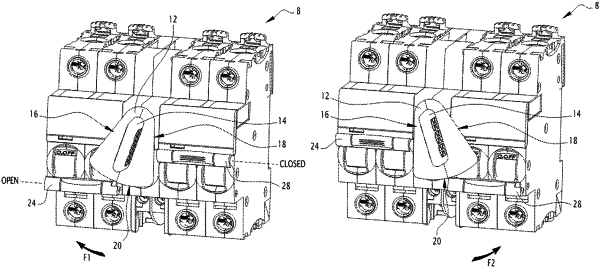| CPC E05B 15/00 (2013.01) [H02B 1/04 (2013.01)] | 18 Claims |

|
1. A locking device for an electrical switchboard, comprising:
a housing intended to be mounted on the electrical switchboard between a first switching apparatus and a second switching apparatus, each of the first and second switching apparatuses having a control lever able to move between a lower position corresponding to an open state and an upper position corresponding to a closed state;
a locking member able to move in rotation around an axis of rotation essentially at right angles to a front face of the housing, the locking member comprising a blocking edge, a first contact edge and a second contact edge, the blocking edge being located between the first contact edge and the second contact edge,
the locking member being able to move reversibly between:
a first locking position, in which the locking member blocks the control lever of the first switching apparatus in its lower position, by cooperation of the blocking edge with the control lever of the first switching apparatus, the second contact edge being in-line with or substantially parallel to a direction of movement of the control lever of the second switching apparatus to allow a movement of the control lever of the second switching apparatus to its upper position,
a second locking position, in which the locking member blocks the control lever of the second switching apparatus in its upper position, by cooperation of the blocking edge with the control lever of the second switching apparatus, the first contact edge being in-line with or substantially parallel to a direction of movement of the control lever of the first switching apparatus to allow a movement of the control lever of the first switching apparatus to its upper position,
wherein the locking member is also able to move into a third, intermediate locking position between the first locking position and the second locking position, in which the control levers of the first and second switching apparatuses are both held in theft lower positions by the blocking edge, thereby preventing the control levers of the first and second switching apparatuses from being moved to theft upper positions.
|